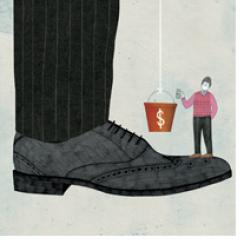Ah, the heady days of summer 2007: Hillary Clinton appeared to have a lock on the Democratic nomination for president, Bernie Madoff was a well-respected money manager, and the buzz among alternative-investment big shots was about going public and attracting tons of so-called permanent capital. Blackstone Group went first. Many people gasped as Stephen Schwarzman, CEO of the New York–based private equity firm, earned a cash payout of nearly $700 million in Blackstone’s initial public offering that June.
Soon after, the U.S. housing market began to collapse, and the rest is history — or at least ongoing testimony. Many a hedge fund manager’s and private equity titan’s IPO dreams, including those of the principals at Kohlberg Kravis Roberts & Co., were destroyed by reverberations from the economic crisis.

The New York–based firm, with $52.2 billion in assets as of December 31, first filed an S-1 with the Securities and Exchange Commission a mere two weeks after arch-rival Blackstone’s hugely successful IPO, which raised $4.13 billion. KKR, founded in 1976 by former Bear, Stearns & Co. partners Jerome Kohlberg Jr., Henry Kravis and George Roberts, hoped to raise at least $1.25 billion.
As market conditions rapidly deteriorated, KKR had to change tack. In mid-August 2008, barely a month before the collapse of Lehman Brothers Holdings sent markets worldwide into a tailspin, the buyout firm unveiled a new strategy: KKR would buy all of its Guernsey Island–based permanent-capital fund KKR Private Equity Investors, which trades on the Euronext Amsterdam exchange. At the time KPE shares were trading below net asset value.
Thus, says Michael Kim, an analyst with New York investment bank Sandler O’Neill + Partners, the transaction was a clever way for KKR “to kill two birds with one stone”: going public by joining with KPE and assuming its stock exchange listing, while simultaneously resolving the fund’s NAV-discount issue by absorbing it into the mother ship. KPE shareholders were offered a 21 percent stake in the combined entity, which would be called KKR & Co. (Guernsey).
The deal was completed a year later — after some wrangling, KPE shareholders received a larger, 30 percent stake in KKR & Co. — then the merged entity was listed on the Euronext exchange while the company moved forward with plans to transfer the listing to the NYSE. In other words, it was a reverse IPO. For its part, the buyout firm got a timely booster shot of permanent capital: Teaming up with KPE added almost $10 billion to KKR’s asset base.
In February stockholders were notified that KKR was preparing to make the move to New York and that they would receive one Big Board share for each of their Euronext shares. (KKR will cease to trade on Euronext.) The company plans to list 204.9 million common shares, valued at $2.2 billion. The remaining 70 percent of the shares will be held by the principals. The timing of the listing has not been disclosed.
Transferring its listing to New York will bolster KKR’s access to public funds at a time when many investors are disenchanted with private equity. “You open the stock up to a much broader potential investor base,” notes Kim. It is perhaps no coincidence that KKR rival Apollo Global Management, a New York–based firm with $53.6 billion in assets, is also renewing efforts to list on the NYSE.
By backing in to an NYSE listing, KKR avoids much of the uncertainty of launching an IPO in a market still hostile to its key business: large leveraged buyouts. But market timing isn’t the only kind of timing that matters with IPOs. Kravis and Roberts, KKR’s remaining co-founders and co-CEOs (Kohlberg left the firm in 1987), are both 66, and it’s a lot easier to cash in some of their stake if the company is publicly traded.






